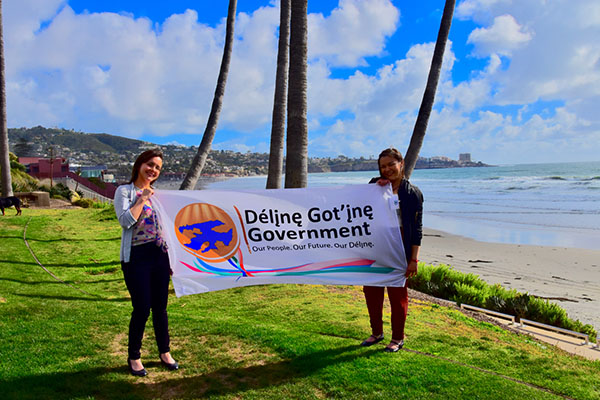5th ABoVE Science Team Meeting Summary
The 5th meeting of the ABoVE Science Team (ASTM5) was held in San Diego, CA from May 20-23 2019. There were approximately 125 attendees from NASA and other US federal agencies, Alaska, and a variety of Canadian federal agencies, a non-profit conservation organization, and indigenous groups. There were also many attendees from US, Canadian and European universities. The overarching goal of the meeting was to collectively assess the latest in ABoVE science via a series of invited plenary talks, partner presentations, posters sessions, and lively breakout discussions. Invitational travel helped 6 students, postdoctoral researchers and collaborators attend. Many of the 84 poster presentations were led by students and postdocs, and the afternoon poster sessions provided vibrant and productive interactions among meeting participants.
The ASTM5 provided an opportunity for newly selected projects to introduce their work and learn about the ABoVE successes and challenges to date. During the plenary sessions, team members learned about the data products resulting from the ongoing airborne campaigns, emerging scientific understanding and research needs, environmental and climatic change in the broader, pan-Arctic context, and the ongoing activities of our state, national, and international partners. The applied sessions had more in-depth exploration of technical issues, approaches, and tools of ABoVE researchers. The breakout sessions enabled thematic teams to discuss current and ongoing collaborations, with additional time provided from cross-thematic discussions. Poster sessions allowed for the opportunity for individual projects to share scientific details of their ongoing work. The variety of activities and opportunities for both formal and informal interactions kept the meeting lively and engaging.
Results from the 66 NASA-funded projects as well as 21 affiliated projects were discussed via the invited plenary and partner presentations as well as during the poster sessions. In addition, the 19 ABoVE Phase-2 PIs gave speed talks and posters on their newly funded projects. The plenary presentations were all excellent, nicely placing ABoVE research in a broader context. These included talks on Arctic vegetation dynamics, gaps in our understanding of the role snow plays in Arctic and boreal ecosystems, fire disturbance and legacy carbon, Indigenous perspectives and co-production of knowledge, and integrated ecosystem modeling, among others. Partner presentations nicely complemented the plenaries and breakout session discussions of synthesis activities by providing overviews of existing and potential synergies with large research programs like NGEE-Arctic, POLAR Canada, Global Water Futures and the Canadian Forest Service. All presentations, including breakout session reports, can be downloaded from the online meeting agenda (no login required).

One key highlight was a plenary presentation on Indigenous Perspectives and Co-production of Knowledge by Mandy Bayha and Joanne Speakman, students Indigenous to the Sahtu Region of the Northwest Territories. Their presentation nicely articulated the importance of combining traditional knowledge and western science to tackle climate change issues, especially in the rapidly changing Arctic where Indigenous residents are already experiencing drastic ecosystem changes that threaten their livelihoods. Joanne and Mandy also gave a scintillating recount of their experience flying in a NASA G-III aircraft during a UAVSAR collect and an associated field data collection excursion in the 2018 field season. Read an associated story here.
It was clear from both oral and presentations that airborne data collected during the previous field seasons continue to pay huge dividends. For example, L-band data from UAVSAR and P-band data from AirMOSS have led to significant improvements in our ability to remotely quantify active layer thickness (ALT). These SAR based approaches for assessing ALT will continue to mature through on-going ABoVE research, ultimately paving the way for large scale assessments of ALT via data from the forthcoming NISAR mission. In addition, data acquired by the next generation Airborne Visible Infrared Imaging Spectrometer (AVIRIS-ng) is being successfully used to detect areas of CH4 enhancement associated with thermokarst and other permafrost disturbance within the ABoVE domain. These results will help constrain uncertainties in the current Arctic-boreal CH4 budget and the amount of future CH4 emissions in the permafrost carbon feedback. The poster presentations also highlighted many of the high impact research results coming out of Phase-I ABoVE projects, including seasonal atmospheric CO2 amplification effects and source regions, comparisons of ground- and satellite-based trends in greening and browning between Arctic-boreal regions, influences of forest composition and structure on NDVI trends, and many other important research advances.
There were also several productive breakout sessions, including those focused on both the thematic working groups (WG) as well as more cross-disciplinary breakouts addressing a number of topics (e.g. interactions of fire disturbance and vegetation; permafrost, carbon and hydrology; and scaling using both statistical approaches and terrestrial biosphere models). One of the outcomes of these various breakout sessions was initiation of a number of new synthesis activities, for which a list will be posted on the ABoVE web site. As part of both plenary and breakout sessions the ST decided to spin off a new working group focused on “snowscapes” (i.e. snow effects on various aspects of ABoVE research), reorient the Wildlife and Ecosystem Services WG to the newly renamed Ecosystem Services and co-Production WG, and also divide the Vegetation Dynamics WG into Vegetation Structure & Function (including aboveground biomass) and Vegetation Dynamics & Distribution. Leads of these WGs, as well as changing leadership and membership of all the WGs are available on the ABoVE web site. We remind all ST members that they can join (or leave) any WG via the web site and also express interest in joining any synthesis activity by contacting the leads of those efforts (if you’re not sure who they are feel free to ask the leadership group or the ABoVE support team).
Airborne data collection plans for the 2019 field season were also discussed in depth, and will include AVIRIS-NG, UAVSAR, and LVIS acquisitions. A fuller summary of 2019 airborne acquisition plans is included elsewhere in this newsletter, and a fuller summary of ASTM5 will be coming out in the summer edition of the NASA Earth Observer (and will be posted to the ABoVE web site).
The consensus of those in attendance at ASTM5 was that it is clear ABoVE continues to be innovative, productive and impactful, including more than 135 publications, several in top tier journals such as Nature, Science, and PNAS. ABoVE also continues to broaden its impact via increased sharing of data sets through the Oak Ridge National Laboratory Distributed Active Archive Center (ORNL DAAC). Currently there are 80 ABoVE data products stored at the ORNL DAAC with 2,700 unique users of ABoVE datasets. The ORNL DACC presented three awards to ABoVE scientists including Logan Berner who received the ‘DACC Staff Favorite’ award, Mark Carroll who received the ‘Outstanding Representation in the Literature’ award, and Tatiana Loboda who received the ‘Most Downloaded Dataset’ award.
Finally, we sincerely thank all of those who participated in the meeting, and especially the members of the organizing committee whose efforts led to an extremely productive and rewarding meeting. We very much look forward to seeing all of you in Fairbanks, AK the week of May 11th 2020 for the 6th ABoVE Science Team Meeting!
|



